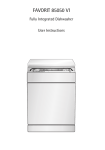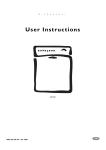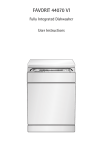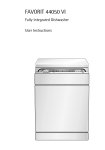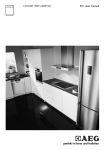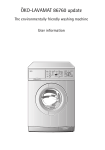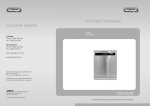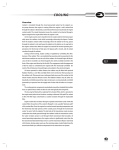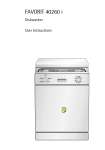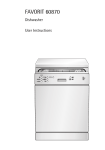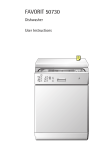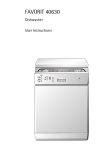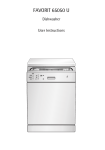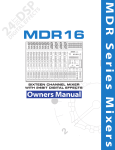Download Electrolux ESI 6220 User's Manual
Transcript
D i s h w a s h e r User Instructions ESI 6220 ANC 822 960 473 - 00 - 0303 GB Dear customer, Please read these user instructions carefully. Above all please observe the safety instructions on the first few pages ofthese user instructions! Please keep these user instructions for later reference. Pass them on to any subsequent owner of the appliance. 1 The warning triangle and/or specific words (Warning!, Caution!, Important!) are used to highlight instructions that are important for your safety or for the function of the appliance. It is imperative that these instructions are observed. Numbered instruction steps lead you step by step through the operation of the appliance. 3 Next to this symbol you receive additional information and practical tips on using the appliance. 2 Tips and instructions for the economical and environmentally conscious use of the appliance are marked with a clover leaf. In the event of a malfunction, these operating instructions contain information on how to rectify faults yourself, see the "What to do, if..." section. If these instructions are insufficient, please contact your nearest Service Force Centre. In this respect please read the "Service and Spare Parts"section at the rear of these user instructions. 2 3 Your dishwasher is fitted with the new "PULSE WASH" wash system. With this wash system, the motor speed and spray pressure are varied during the wash programme to improve the cleaning of the dishes. It is for this reason that the noise level changes during the wash programme. Contents Safety Instructions . . . . . . . . . . . . . . . . . . . . . . . . . . . . . . . . . . . . . . . . . . . . . . . . . . . . . . . . . . . . . . . . . . . . . . 5 Disposal . . . . . . . . . . . . . . . . . . . . . . . . . . . . . . . . . . . . . . . . . . . . . . . . . . . . . . . . . . . . . . . . . . . . . . . . . . . . . . 6 Economical and Ecological Dishwashing . . . . . . . . . . . . . . . . . . . . . . . . . . . . . . . . . . . . . . . . . . . . . . . . . . . 6 Appliance Features and Control Panel . . . . . . . . . . . . . . . . . . . . . . . . . . . . . . . . . . . . . . . . . . . . . . . . . . . . . 7 Control Panel . . . . . . . . . . . . . . . . . . . . . . . . . . . . . . . . . . . . . . . . . . . . . . . . . . . . . . . . . . . . . . . . . . . . . . . . . . . 8 Prior to using for the first time . . . . . . . . . . . . . . . . . . . . . . . . . . . . . . . . . . . . . . . . . . . . . . . . . . . . . . . . . . . . 8 Adjusting the Water Softener . . . . . . . . . . . . . . . . . . . . . . . . . . . . . . . . . . . . . . . . . . . . . . . . . . . . . . . . . . . . . . . 9 Filling with Special Salt for the Water Softener . . . . . . . . . . . . . . . . . . . . . . . . . . . . . . . . . . . . . . . . . . . . . . . . 11 Filling with Rinse Aid . . . . . . . . . . . . . . . . . . . . . . . . . . . . . . . . . . . . . . . . . . . . . . . . . . . . . . . . . . . . . . . . . . . . 12 Adjusting Rinse Aid Dosing . . . . . . . . . . . . . . . . . . . . . . . . . . . . . . . . . . . . . . . . . . . . . . . . . . . . . . . . . . . . . 12 In Daily Use . . . . . . . . . . . . . . . . . . . . . . . . . . . . . . . . . . . . . . . . . . . . . . . . . . . . . . . . . . . . . . . . . . . . . . . . . . . 13 Loading cutlery and dishes . . . . . . . . . . . . . . . . . . . . . . . . . . . . . . . . . . . . . . . . . . . . . . . . . . . . . . . . . . . . . . . 13 Loading Cutlery . . . . . . . . . . . . . . . . . . . . . . . . . . . . . . . . . . . . . . . . . . . . . . . . . . . . . . . . . . . . . . . . . . . . . . 14 Loading Pans, Frying Pans and Large Plates . . . . . . . . . . . . . . . . . . . . . . . . . . . . . . . . . . . . . . . . . . . . . . . 15 Loading Cups, Glasses and Coffee Services . . . . . . . . . . . . . . . . . . . . . . . . . . . . . . . . . . . . . . . . . . . . . . . 16 Adjusting the Height of the Upper Basket . . . . . . . . . . . . . . . . . . . . . . . . . . . . . . . . . . . . . . . . . . . . . . . . . . 16 Filling with Detergent . . . . . . . . . . . . . . . . . . . . . . . . . . . . . . . . . . . . . . . . . . . . . . . . . . . . . . . . . . . . . . . . . . . . 17 Use of "3 in 1"/ Combi Detergent Tablets . . . . . . . . . . . . . . . . . . . . . . . . . . . . . . . . . . . . . . . . . . . . . . . . . . 18 Concentrated Detergent . . . . . . . . . . . . . . . . . . . . . . . . . . . . . . . . . . . . . . . . . . . . . . . . . . . . . . . . . . . . . . . 18 Selecting the Wash Programme (Programme Table) . . . . . . . . . . . . . . . . . . . . . . . . . . . . . . . . . . . . . . . . . . . 19 Start the wash programme . . . . . . . . . . . . . . . . . . . . . . . . . . . . . . . . . . . . . . . . . . . . . . . . . . . . . . . . . . . . . . . . 20 Interrupting or ending the wash programme . . . . . . . . . . . . . . . . . . . . . . . . . . . . . . . . . . . . . . . . . . . . . . . . 20 Pause function . . . . . . . . . . . . . . . . . . . . . . . . . . . . . . . . . . . . . . . . . . . . . . . . . . . . . . . . . . . . . . . . . . . . . . 20 Load Sensing . . . . . . . . . . . . . . . . . . . . . . . . . . . . . . . . . . . . . . . . . . . . . . . . . . . . . . . . . . . . . . . . . . . . . . . 20 Switching Off the Dishwasher . . . . . . . . . . . . . . . . . . . . . . . . . . . . . . . . . . . . . . . . . . . . . . . . . . . . . . . . . . . . . 20 Care and Cleaning . . . . . . . . . . . . . . . . . . . . . . . . . . . . . . . . . . . . . . . . . . . . . . . . . . . . . . . . . . . . . . . . . . . . . 21 Cleaning the Filter . . . . . . . . . . . . . . . . . . . . . . . . . . . . . . . . . . . . . . . . . . . . . . . . . . . . . . . . . . . . . . . . . . . . . . 21 What to do if ... . . . . . . . . . . . . . . . . . . . . . . . . . . . . . . . . . . . . . . . . . . . . . . . . . . . . . . . . . . . . . . . . . . . . . . . . 22 ...Fault warnings are displayed. . . . . . . . . . . . . . . . . . . . . . . . . . . . . . . . . . . . . . . . . . . . . . . . . . . . . . . . . . . . . 22 ...there are problems operating the dishwasher. . . . . . . . . . . . . . . . . . . . . . . . . . . . . . . . . . . . . . . . . . . . . . . . 23 ...the wash results are unsatisfactory. . . . . . . . . . . . . . . . . . . . . . . . . . . . . . . . . . . . . . . . . . . . . . . . . . . . . . . . 23 Technical Data . . . . . . . . . . . . . . . . . . . . . . . . . . . . . . . . . . . . . . . . . . . . . . . . . . . . . . . . . . . . . . . . . . . . . . . . 24 Notes for Test Institutes . . . . . . . . . . . . . . . . . . . . . . . . . . . . . . . . . . . . . . . . . . . . . . . . . . . . . . . . . . . . . . . . 25 3 Contents Installation and Connection Instructions . . . . . . . . . . . . . . . . . . . . . . . . . . . . . . . . . . . . . . . . . . . . . . . . . . . 27 Installing the Dishwasher . . . . . . . . . . . . . . . . . . . . . . . . . . . . . . . . . . . . . . . . . . . . . . . . . . . . . . . . . . . . . . . 27 Dishwashers That Can Be Integrated . . . . . . . . . . . . . . . . . . . . . . . . . . . . . . . . . . . . . . . . . . . . . . . . . . . . . 27 Built-In Dishwasher . . . . . . . . . . . . . . . . . . . . . . . . . . . . . . . . . . . . . . . . . . . . . . . . . . . . . . . . . . . . . . . . . . . 28 Free-Standing Appliances . . . . . . . . . . . . . . . . . . . . . . . . . . . . . . . . . . . . . . . . . . . . . . . . . . . . . . . . . . . . . . 28 Connecting the Dishwasher . . . . . . . . . . . . . . . . . . . . . . . . . . . . . . . . . . . . . . . . . . . . . . . . . . . . . . . . . . . . . 29 Water Connection . . . . . . . . . . . . . . . . . . . . . . . . . . . . . . . . . . . . . . . . . . . . . . . . . . . . . . . . . . . . . . . . . . . . . . 29 Permitted water pressure . . . . . . . . . . . . . . . . . . . . . . . . . . . . . . . . . . . . . . . . . . . . . . . . . . . . . . . . . . . . . . 29 Connect the inlet hose . . . . . . . . . . . . . . . . . . . . . . . . . . . . . . . . . . . . . . . . . . . . . . . . . . . . . . . . . . . . . . . . 29 Water drain . . . . . . . . . . . . . . . . . . . . . . . . . . . . . . . . . . . . . . . . . . . . . . . . . . . . . . . . . . . . . . . . . . . . . . . . . 31 Leak Prevention System . . . . . . . . . . . . . . . . . . . . . . . . . . . . . . . . . . . . . . . . . . . . . . . . . . . . . . . . . . . . . . . 31 Electrical Connection . . . . . . . . . . . . . . . . . . . . . . . . . . . . . . . . . . . . . . . . . . . . . . . . . . . . . . . . . . . . . . . . . . . . 32 Connections . . . . . . . . . . . . . . . . . . . . . . . . . . . . . . . . . . . . . . . . . . . . . . . . . . . . . . . . . . . . . . . . . . . . . . . . . . . 33 Guarantee Conditions . . . . . . . . . . . . . . . . . . . . . . . . . . . . . . . . . . . . . . . . . . . . . . . . . . . . . . . . . . . . . . . . . . 34 Service and Spare Parts . . . . . . . . . . . . . . . . . . . . . . . . . . . . . . . . . . . . . . . . . . . . . . . . . . . . . . . . . . . . . . . . . 35 4 1 Safety Instructions The safety aspects of ELECTROLUX electrical appliances comply with accepted technical standards and the German Appliance Safety Law. Nevertheless, as a manufacturer we consider it our obligation to make you aware of the following safety information: Installation, Connection and Placing into Operation • • • • The dishwasher may only be transported upright. Check the dishwasher for transport damage. Do not in any circumstances connect an appliance that is damaged. In the case of damage, please contact your supplier. Prior to placing the appliance in operation, ensure that the nominal voltage and type of supply on the rating plate match that of the supply where the appliance is to be installed. The fuse rating is also to be found on the rating plate. For information on how to correctly install and connect up your dishwasher, please read the “Installation“ section. Multiway plugs / connectors and extension cables must not be used. This could constitute a safety hazard. • • • • • • Correct Use • Child Safety • • • • • Children often do not recognise the hazards associated with the use of electrical appliances. It is therefore important that you ensure children are adequately supervised and that you do not allow children to play with the dishwasher – there is a risk that children can shut themselves inside the appliance (risk of suffocation!). Packaging materials (e.g. films, styrofoam) can be dangerous for children. Risk of suffocation! Keep packaging away from children. Detergents can cause burns to the eyes, mouth, and throat, or even cause choking! Please observe the manufacturer's safety instructions for cleaners and detergents. The water in your dishwasher is not suitable for drinking. If there are still remnants of detergent in the appliance, there is a risk of burns! When disposing of the dishwasher: unplug from the mains, cut off and dispose of the mains cable. Break the door lock so that the door no longer shuts. General Safety • Repairs to the dishwasher are only to be carried out by qualified service engineers. Improper repairs can give rise to significant hazards for the user. If your appliance needs repairing, please contact customer service or your dealer. Never place the dishwasher in operation if the mains cable, water inlet or drain hose is damaged; or the control panel, work top or plinth area is damaged such that the inside of the appliance is freely accessible. If the mains lead is damaged, or is to be replaced for a longer lead, the cable (obtainable from ELECTROLUX Service Force) must be changed by a service engineer authorised by ELECTROLUX. Never unplug the appliance by pulling on the cable, always pull the plug. Additions or modifications to the dishwasher are not permitted for safety reasons. Ensure that the door of the dishwasher is always closed when it is not being loaded or unloaded. In this way you will avoid anybody tripping over the open door and hurting themselves. Sharp knives and items of cutlery with sharp edges must be placed in the cutlery tray or in the upper basket. • • • • • Only wash household dishes using the dishwasher. If the appliance is used for other purposes, or is used incorrectly, the manufacturer cannot accept any liability for any damage caused. Prior to use, ensure that the manufacturers of the special salt, detergent, and rinse aid employed specifically permit the usage of their products in household dishwashers. Do not put any solvents in the dishwasher. There is a risk of an explosion! The anti-flood system provides dependable protection against damage due to leaks. For this system to function correctly, the following preconditions must be met: – The appliance must remain connected to the mains even when it is switched off. – The dishwasher must be correctly installed. – Always shut off the water supply at the tap when the dishwasher is not to be used for longer periods, e.g. when you are away on holiday. Do not sit or stand on the open door, the appliance may tip over. In the event of a fault, first close the tap, then switch off the appliance and unplug it from the mains. If the appliance is permanently wired to the mains: switch off the fuse(s) or unscrew them. 5 2 Disposal Disposing of the Packaging Material Dispose of the dishwasher packaging material correctly. All the packaging materials used are harmless to the environment and can be recycled. • Plastic parts are marked with standard international abbreviations: – >PE< for polyethylene, e.g. sheet wrapping material – >PS< for polystyrene, e.g. padding material (always CFC-free) – >POM< for polyoxymethylene, e.g. plastic clips • Cardboard packaging is manufactured from recycled paper and should be deposited in the waste paper collection for recycling. Disposal of old appliances As and when you cease to use your dishwasher, please take it to a recycling centre or to your dealer who will, for a small contribution to the costs, dispose of it for you. 2 Economical and Ecological Dishwashing • • • • • • 6 Only connect the dishwasher to the cold watersupply. Ensure that the water softener is correctly adjusted. Do not pre-rinse dishes under running water. When you wash a small load, the load sensor calculates the amount of water necessary and shortens the programme. It is more economical to always wash with a full load. Select the wash programme to suit the nature and degree of the soiling on the dishes. Do not use more detergent, special salt or rinse aid than is recommended in these operating instructions and by the manufacturer of the respective product. Appliance Features and Control Panel Top Spray Nozzle Rubber Seal for Connecting the Water Feed to the Spray Arm Spray Arms Water hardness switch Container for Special Salt Container for Detergent Container for Rinse Aid Rating Plate Filters 7 Control Panel Water softener button Function button Multidisplay Wash programme buttons Control indicator Water softener and function button: In addition to the indicated wash programme, the dishwasher water softener can be set using a combination of these buttons. The 3 lights on the : Top light multidisplay : Middle light can display : • the current : Bottom light stage of the wash programme selected. • which fault has occurred in the dishwasher. Door handle ON / OFF button The indicator has the following meaning: t 3 The control indicator never illuminates while a wash programme is running. Prior to using for the first time Prior to using for the first time, remove all the clips with which the dish baskets are secured for transport. Then perform the following steps: 1. Adjust the water softener 2. Filling with Special Salt for the Water Softener 3. Filling with Rinse Aid 8 Refill with special salt Adjusting the Water Softener To prevent the build up of scale on dishes and in the dishwasher, the dishes must be washed with soft, i.e. low lime content water. For this reason the dishwasher is fitted with a water softener in which tap water from a hardness of 4 °d (German degree) is softened with the aid of special salt. Your local water authority can advise you on the hardness of the water in the area where you live. The water softener can be set manually using the water hardness switch; it can also be set electronically using the buttons on the control panel. 3 Water Hardness in °d1) in inPPM2) Hardness Setting Range 41 - 50 730 - 900 IV 30 - 40 530 - 720 IV 19 - 29 330 - 520 III/IV 4 - 18 70 - 320 I/II/III less than 4 less than 70 I Manual 1 0* Electronic Number of Flashes 5 5 4 4 3* 3 2 2 1 no salt necessary 1 1)(°d) German degree, measure of the hardness of water 2)(PPM), Parts Per Million, international units of water hardness *factory setting Adjust the water softener to the setting given in the table that corresponds to the hardness of the water in the area where you live. It is only possible to adjust the water hardness setting when there is no programme running. If you have inadvertently started a programme (an LED indicator is constantly illuminated), then the programme must be cancelled by pressing the appropriate button. 1. The dishwasher must be switched off. 2. Manual setting: Open the door on the dishwasher. 3. Remove the lower basket from the dishwasher. 4. Turn the water hardness switch to 0 or 1. 5. Re-position the lower basket. 6. Electronic setting: Press the water-softener and function buttons simultaneously and keep them pressed. 7. In addition press the ON/OFF button. 8. The LED indicator for the water-softener button flashes. 9. Press the water-softener button again. – The LED indicator for the water-softener button will be illuminated continuously for an initial 5 seconds and then begin to flash. – The number of flashes corresponds to the hardness setting. – The sequence of flashes is repeated several times after a 5 second pause. 10.Each time you press the water-softener button the hardness setting will go up by 1. (Exception: Hardness setting 1 follows hardness setting 5). 1 9 – If the hardness setting is changed, the LED indicator for the water-softener button will confirm the change by remaining illuminated continuously for 5 seconds and then flashing again. – The number of flashes corresponds to the new hardness setting. – The sequence of flashes is repeated several times after a 5 second pause. 11.Once the hardness setting is correct press the ON/OFF switch. The hardness setting is then saved. 10 Filling with Special Salt for the Water Softener 1 Use only special salt for dishwashers. Never fill the salt container with any another type of salt (e.g. culinary salt) or dishwasher detergent. This would irreparably damage the water softener. Prior to filling with salt, please check each time that you really do have a packet of special salt in your hand. Fill with special salt: • • Prior to using the dishwasher for the first time on the control When the SALT indicator panel is illuminated. 3 t If the water hardness in your area is less than 4 °d, you do not need to use special salt. 1. Open the door, remove the lower basket. 2. Undo the lid on the salt container by turning it anticlockwise. 3. Only when using for the first time: fill the salt container with water. 4. Place the funnel supplied on the container opening. Fill the container with special salt through the funnel; the capacity of the container is approx. 1.01.5 kg depending on the grain size. Do not overfill the salt container with special salt. LE SA ALT Z S AL S EL S The water expelled by filling the salt container with special salt runs out of the salt container onto the base of the washing compartment. This is not a cause for concern, the water will be pumped out at the start of the next wash programme. 5. Clean any salt remnants on the container opening. 6. Turn the lid clockwise to the stop, otherwise special salt will leak into the wash water, this could lead to poor wash results. To avoid this run a rinse programme after filling the salt container with special salt. This will wash away salt water and any salt crystals that have been spilt. 3 3 Depending on the size of the salt grains, it can take several hours for the salt to dissolve in the water and the special salt indicator to extinguish. The setting of the water softener and thus the consumption of salt are dependent on the hardness of the local water. t 11 Filling with Rinse Aid Rinse aid ensures that your dishes gleam and are free from spots, and that you glasses are clear. 1 Use only branded rinse aid for dishwashers. Never fill the rinse aid container with any another substance (e.g. concentrated vinegar). This would damage the appliance. Fill with rinse aid: • • Prior to using the dishwasher for the first time. When a dark point surrounded by a light ring is to be seen in the indicator window on the container. If there is rinse aid in the container, the indicator window is uniformly dark. The rinse aid compartment is on the inside of the dishwasher door. 1. Open the door. 2. Press the rinse aid compartment release button with your finger. 3. Fully open the rinse aid compartment lid. 4. Fill with rinse aid exactly up to the level marked “max”; this corresponds to a quantity of approx. 140 ml. 5. Close the lid and press until it locks into place. 6. Wipe up any spilt rinse aid with a cloth. Otherwise too much foam will be formed during the wash. Adjusting Rinse Aid Dosing As the dishes are washed rinse aid is released from the dispenser into the wash water. The dose is factory set at 4, and can be adjusted from 1 to 6. Only change the setting if streaks, milky spots or dried on water marks are visible on glasses or crockery. Open the door of the dishwasher. Press the rinse aid compartment release button with your finger. Fully open the rinse aid compartment lid. Set the dose level. Close the lid and press until it locks into place. If rinse aid has run out, wipe up with a cloth. 3 1. 2. 3. 4. 5. 6. 12 In Daily Use • • • • • Is it necessary to refill with special salt or rinse aid? Load cutlery and dishes into the dishwasher Fill with dishwasher detergent Select a wash programme suitable for the cutlery and dishes Start the wash programme Loading cutlery and dishes 1 Sponges, household cloths and any object that can absorb water may not be washed in the dishwasher. For washing in the dishwasher the following cutlery/dishes are not suitable: – Cutlery with wooden, horn, china or mother of pearl handles – Plastic items that are not heat resistant – Older cutlery with cement that is not temperature resistant – Bonded cutlery items or dishes – Pewter or copper items – Lead crystal glass – Steel items subject to rusting – Wooden platters – Items made from synthetic fibres • • are of limited suitability: – Only wash stoneware in the dishwasher if it is specifically marked as being dishwasher-safe by the manufacturer. – Glazed patterns may fade if machine washed frequently. – Silver and aluminium parts have a tendency to discolour during washing. Left-overs, e.g. egg white, egg yolk and mustard often cause discolouring and staining on silver. Therefore always clean left-overs from silver immediately, if it is not to be washed straight after use. – Some types of glass can become dull after a large number of washes. Before loading the dishes, you should: – Remove large left-overs. – Soften remnants of burnt food in pans. When loading the dishes and cutlery, please note: – Dishes and cutlery must not impede the rotation of the spray arms. – Load hollow items such as cups, glasses, pans, etc. with the opening downwards so that water cannot collect in the container or a deep base. – Dishes and items of cutlery must not lie inside one another, or cover each other. – To avoid damage to glasses, they must not touch. – Do not lay small objects (e.g. lids) in the cutlery basket. 13 Loading Cutlery 1 Long bladed knives stored in an upright position are a potential hazard. 1 Long and/or sharp items of cutlery such as carving knives must be positioned horizontally in the upper basket. 1 Take care when loading or unloading sharp items such as knives. To ensure that all items of cutlery are completely washed, you should 1. Place the grid insert on the cutlery basket. 2. Place short knives, forks and spoons in the grid insert with their handles pointing downwards. Some models of dishwasher have cutlery baskets without a cutlery grid. 14 Loading Pans, Frying Pans and Large Plates Load large and heavily soiled dishes in the lower basket (Plates up to 29cm in diameter). Your dishwasher has one of the following two types of lower basket: Type 1: The rear plate insert in the lower basket can be removed 3 To make it easier to load large dishes, it is possible - to remove the plate inserts from the lower basket. - to move the cutlery basket sideways. Type 2: The rear plate insert in the lower basket can be folded on its side 3 To ease the loading of large items, - the two rows of prongs in the rear plate insert can be folded across one another. - the cutlery basket in the lower basket can be moved to the side. 15 Loading Cups, Glasses and Coffee Services Load small, delicate items and long pointed cutlery in the upper basket. • Arrange plates and dishes offset on and under the folding cup racks so that washing water can reach all items. • The cup racks can be folded up out of the way for tall items. • Lay or hang wine, champagne, and brandy glasses in the cut outs on the cup racks. • Glasses, beakers, etc. can also be placed on the two rows of prongs on the left of the upper basket. Adjusting the Height of the Upper Basket Maximum Height of the Dishes in the Upper Basket Lower Basket With upper basket raised 22 cm 30 cm With upper basket lowered 24 cm 29 cm 3 The height of the basket can also be adjusted when it is loaded. Lowering the Upper Basket: 1. Pull the upper basket out completely. 2. Holding the upper basket by the handle, lift it as far as it will go and then lower it vertically. The upper basket will engage in the lower position. Raising the Upper Basket: 1. Pull the upper basket out completely. 2. Holding the upper basket by the handle, lift it as far as it will go and then lower it vertically. The upper basket will engage in the higher position. 16 Filling with Detergent 1 Only use dishwasher detergent. Fill with detergent: Prior to the start of a wash programme (not for the pre wash programme). The detergent is released into the wash water during the programme. 2 Please observe the manufacturer's dosing and storage recommendations as stated on the detergent packaging. The detergent compartment is on the inside of the dishwasher door. 1. If the lid is closed: press release button (1). The lid springs open. 2. Fill the detergent dispenser with detergent. The markings indicate the dosing levels: “20” corresponds to approx. 20 ml of detergent, “30” corresponds to approx. 30 ml of detergent. 3. Close the lid and press until it locks into place. 3 If the dishes are very heavily soiled put additional detergent into the adjacent chamber (2). This detergent will take effect during the pre wash. 17 Use of "3 in 1"/ Combi Detergent Tablets General Advice These products are tablets with combined detergent/ rinse-aid and salt functions. 1. Before using these products you should first check that the water hardness in your supply is compatible with the use of these products as per the detergent manufacturers instructions (on the product packaging). 2. These products should be strictly used according to the detergent manufacturers instructions. Do not place the tablets in the tub or the cutlery basket as this will result in poorer wash results. The tablets should be placed in the detergent dispenser. 3. If you encounter problems when using "3 in1" products for the first time then please contact the detergent manufacturers care line (the telephone number is given on the product packaging). Concentrated Detergent Based on their chemical composition, dishwasher detergents can be split into two basic types: – conventional, alkaline detergents with caustic components. – low alkaline concentrated detergents with natural enzymes. 2 1 Special Advice When using combination products, the rinse-aid and salt lights are no longer useful. It may be helpful therefore to switch the rinse aid off - please note that only some dishwashers have this facility - and selecting the lowest possible setting for water hardness. For more information please refer to your instruction manual. If you decide to switch to the use of a standard detergent system we advise that you: • Refill both the salt and rinse aid compartments. • Switch the waterhardness setting to the highest possible position and run for three normal cycles without a load. • Readjust the waterhardness setting again according to the conditions for your region (as per the instruction manual). 18 The use of 50 °C wash programmes in conjunction with concentrated detergents reduces pollution and is good for your dishes; these wash programmes are specially matched to the dirt-dissolving properties of the enzymes in the concentrated detergent. For this reason 50 °C wash programmes in which concentrated detergents are used can achieve the same results that can otherwise only be achieved using 65 °C programmes. Detergent Tablets 3 Detergent tablets of different makes dissolve at different speeds. For this reason some detergent tablets cannot develop their full cleaning power during short programmes. Therefore please use wash programmes with pre wash when using detergent tablets. Selecting the Wash Programme (Programme Table) Choose the most suitable wash programme with the aid of this table: Type of Dishes: in addition: Type of Soiling: Dishes without Pans Dinner service and Pans – normal soiling; dried onleft-overs with dishes that are sensitive to changes in temperature normal soiling – dishes that have just been used, normal to slight soiling normal soiling particularly suitable when concentrated detergents are used. Suitable Wash Programme: Press programme button: Programme Sequence 1) Consumption Figures:2) d q ë Pre wash Main wash 2 rinsing Final rinse Drying Pre wash Main wash Rinsing Final rinse Drying 3) î – Main wash Rinsing Final rinse Drying ï 4) – Main wash – Final rinse – Duration 105 - 115 minutes 120 - 130 minutes 75 - 85 minutes 30 minutes Energy 1,75 - 1,95 kWh 0,95 - 1,05 kWh 1,05 - 1,24 kWh 0,8 kWh Water 16 - 18 litres 14 - 16 litres 10 - 12 litres 8 liter 1) The various stages in the wash programme have different sounds because the dishes are washed more intensely for short periods during certain stages of the wash programme to improve cleaning. 2) The consumption figures were determined under standard conditions. They are intended as a guide only and depend on the loading. Variations can occur during normal usage. 3) Test programme. 4) This programme is not suitable when left-overs have dried on. 19 Start the wash programme 1. Check that when the dishes and cutlery are loaded in the dishwasher the spray arms are free to rotate. 2. Open the tap fully. 3. Shut the door. 4. Press the On/Off button. The On/Off button indicator lights up. 5. Press the programme button for the required programme (see “Programme Table”). The programme indicator lights up. One or two lights will flash in the multidisplay. During this time it is possible to reselect the programme. The selected wash programme will start after about 6 seconds. The current wash programme stage will always be shown in the multidisplay. 3 If the top light and/or the middle light in the multidisplay flash after the programme has started please read the section “What to do if...”. Interrupting or ending the wash programme 3 Only interrupt a wash programme that is running if it is absolutely necessary. After the appliance has been closed again the air that has entered will be greatly heated and expand. As a result water may penetrate the base of the appliance and trigger the antiflood system. Interrupt the wash programme by opening the door. Hot steam can escape from the appliance when the door is opened. (deleted by the reviewer) Open the door carefully. 1. Open the door of the dishwasher. The wash programme will stop. 2. Lights are flashing in the multidisplay. 3. Shut the door. The wash programme continues. 1 Ending the wash programme Using the pause function the dishwasher can be temporarily stopped. 1. Press the On/Off button. The wash programme will stop. 2. All indicators will go out. 3. When after a short time the wash programme is to continue, press the On/Off button again. The wash programme will continue. 2 Load Sensing If a wash programme is started even though there are only a few dishes in the upper and/or lower basket, an intelligent electronic system adjusts the amount of water and the duration of the wash programme to the number of dishes. By this means it is possible to wash only a few dishes quickly and economically. At half load (6 place settings), up to 2 litres of water and 0.2 kWh of electricity are saved. Switching Off the Dishwasher Switch off the dishwasher when the programme progress display. 1. Press the ON/OFF button Hot steam may escape from the appliance when opening the door immediately after the end of the programme. Therefore: 2. Open the door carefully. Emptying the Dishwasher 3 Pause function • 20 M. The ON/OFF but- 1 • The pause function can only be initiated before the drying section of the programme. If the pause function is initiated during the drying section of the programme the wash programme is ended. w is illuminated on ton M indicator extinguishes. 1. Press the button for the wash programme that is running and hold it down until the programme indicator for the wash programme goes out. 2. Release the programme button; the wash programme has been ended. 3 The wash programme should not be stopped for a prolonged period or the cooled water will need to be reheated resulting in increased energy consumption. • Hot dishes are sensitive to knocks. The dishes should therefore be allowed to cool down before removing them from the appliance. Leave the dishes in the dishwasher for approx. 15 minutes after the end of the programme so that they dry better and can cool down. First empty the lower basket, and then the upper rack. By using this procedure you will avoid any water that may be remaining in the upper basket, dripping onto the dishes in the lower basket and leaving water marks. Care and Cleaning Do not under any circumstances use furniture care products or aggressive cleaners. If necessary, clean the controls only with a soft cloth and pure warm water. Occasionally check the internal containers, door seal, and water inlet for soiling, clean if necessary. 1 • • Cleaning the Filter 3 The filters in the base of the washing compartment are to a large extent self-cleaning. Nevertheless the filters should be checked and cleaned from time to time. Dirty filters will degrade the washing result. 1. Open the door, remove the lower basket. 2. The dishwasher filter system comprises a coarse/ fine filter, microfilter and a flat filter. Unlock the filter system using the handle on the microfilter, and remove. 3. Turn the handle about ¼ a turn anticlockwise and remove. 4. Take hold of the coarse/fine filter (1) by the handle with the hole and remove from the microfilter (2). 5. Clean all filters thoroughly under running water. 6. Remove the flat filter (3) from the base of the washing compartment and clean both faces thoroughly. 7. Put the flat filter back in the base of the washing compartment. 8. Place the coarse/fine filter in the microfilter and press together. 9. Put the filter combination in place and lock by turning the handle clockwise to the stop. During this process ensure that the flat filter does not protrude above the base of the washing compartment. 1 Under no circumstances may the dishwasher be used without filters. 21 What to do if ... Try to rectify minor faults on the dishwasher with the aid of the instructions given here. If you call in customer service to resolve one of the malfunctions listed here, or rectify an error made in the operation of the appliance, the customer service engineer’s visit is not free of charge, even during the period of guarantee. ...Fault warnings are displayed. • If the top or middle light in the display is flashing you can probably rectify the fault yourself. Once the fault has been rectified press the On/ Off- button. The wash programme will continue. If Symptom The top light in the multidisplay is flashing. There is no water entering the dishwasher the fault is displayed again, contact your local Service Force Centre. • If other lights in the multidisplay flash, please contact Service Force and let them know which fault indicator is flashing. Possible Cause Tap is blocked or furred with lime-scale. Clean tap. The filter (where present) in the threaded hose fitting is blocked. Clean the filter in the threaded hose fitting. The water inlet hose is connected wrongly. Check hose installation. The middle light is flashing The sink outlet is blocked. in the multidisplay. Clean the sink outlet. The water drain hose is connected wrongly. Check hose installation. The anti-flood system has been triggered. Close the tap and contact Service Force. The top and the middle light are flashing in the multidisplay. 22 Solution ...there are problems operating the dishwasher. Symptom The programme does not start. Possible Cause Solution The dishwasher door has not been closed properly. Shut the door. The mains plug is not plugged in. Insert mains plug. House fuse is faulty. Replace fuse. For dishwasher models with delay start timer: Delay start has been selected. If dishes are to be washed immediately cancel delay start timer. The washing compartment is made of anti- Only wash cutlery and dishes that are corrosive stainless steel. Any spots of rust suitable for dishwasher use. Spots of rust are visible inside the washing compartment stem from in the washing compart- other sources (flakes of rust from the water ment. pipe or from pans, cutlery etc.) Remove Close the salt dispenser lid securely. such spots with a commercially available stainless steel cleaner. There is a whistling noise during washing. The whistling is not a cause for concern. Use a different brand of detergent. ...the wash results are unsatisfactory. The dishes are still dirty. The dishes are wet and dull. • • • • • • • • The wrong wash programme was selected. The dishes were arranged in such a way as to stop the water reaching all parts of the surface. The dish racks must not be overloaded. The filters in the base of the washing compartment are dirty or incorrectly positioned. Too little or no detergent was used. Where there are limescale deposits on the dishes: The salt dispenser is empty or the water softener unit is set wrongly. The drain hose is incorrectly connected. Rinse aid was not used. The rinse aid container is empty. There are streaks, milky spots or a bluish coating on glasses and dishes. • Decrease rinse aid dosing. There are dried water drops on the glasses and dishes. • • Increase rinse aid dosing. The detergent may be the cause. Contact the detergent manufacturer's consumer advisor. 23 Technical Data Capacity: 12 place settings including serving dishes Permitted Water Pressure: 1-10 bar (=10-100 N/cm2 = 0.1-1.0 MPa) Electrical Connection: Information on the electrical connection is given on the rating plate on the inner edge of the dishwasher door on the right. Dishwasher: Free-Standing Appliances Dimensions: 850 x 600 x 600 (H x B x D in mm) Max. Weight: 54 Kg Dishwashers that Can Be Integrated, Built-In Dishwashers Dimensions: 820 – 880 x 596 x 570 (H x W x D in mm) Max. Weight: 50 Kg Dishwashers that Can Be Fully Integrated Dimensions: 820 – 880 x 596 x 546 - 550 (H x W x D in mm) Max. Weight: 50 Kg appliance conforms with the following ; This EU Directives: • • 24 73/23/EWG dated 19. 02. 1973 – Low Voltage Directive 89/336/EWG dated 03. 05. 1989 (including Directive Amendment 92/31/ EWG) – EMC Directive Notes for Test Institutes Testing in accordance with EN 60704 must be carried out with the appliance fully loaded and using the test programme (see Programme Table). Tests in accordance with EN 50242 must be carried out when the salt dispenser and rinse aid container have been filled with salt and rinse aid respectively and using the test programme (see Programme Table). Full Load: 12 place settings incl. serving dishes Half Load: 6 place settings incl. serving dishes, leaving alternate positions free Detergent Dosing: 5g + 25g (Type B) 20g (Type B) Rinse Aid Setting: 4 (Type III) 4 (Type III) Sample loading arrangement: Upper basket Sample loading arrangement: Upper basket Sample loading arrangement: Lower basket 25 Sample loading arrangement: Cutlery basket Some dishwasher models have cutlery baskets without a grid insert. 26 INSTALLATION AND CONNECTION INSTRUCTIONS Installing the Dishwasher • • • • • The dishwasher must be installed on a firm floor and adjusted to ensure that it is stable and level. To compensate for unevenness in the floor and to match the height of the appliance to that of surrounding units extend the threaded feet by unscrewing : – use a screwdriver. For built-in, integrated and fully integrated dishwashers, the rear feet should be adjusted from the front of the appliance using a screwdriver. The drain hose, inlet hose and mains cable must not be kinked or crushed when the dishwasher is in position. The dishwasher must also be screwed on tightly to the work surface or to the adjoining units. This is essential to ensure the diswasher does not tip. Depending on type, the dishwasher is to be installed as follows: Dishwashers That Can Be Integrated (see installation template supplied) 3 The door of the appliance can be fitted with a wooden furniture door with the following dimensions Width: 591 – 594 mm Thickness: 16 – 24 mm Height: (variable) dependent on Weight: max. 8 kg 1 - Recess height - Plinth height - The adjustment so that the unit matches the height of the adjoining units The exact height of the adjoining units must be measured at the place of installation. If the facing panel is longer than 600 mm, the door of the appliance cannot be opened completely (the facing panel bumps against the plinth). If this is the case, the plinth must be cut out (see installation template) or the brace adapter for the extra long door BLT 60 must be used. You can obtain this with the E No. 911 239 008. 27 Built-In Dishwasher (see enclosed installation instructions) Free-Standing Appliances 1 can be set up as stand-alone without additional installation. If the dishwasher is set up next to a cooker, a heat-insulating, non-flammable plate must be mounted between the dishwasher and the cooker, flush to the top edge of the work surface (depth 57.5 cm). The plate should have aluminium foil on the side facing the cooker. If the dishwasher is installed underneath a kitchen work surface, the original work surface of the dishwasher is to be removed as follows: 1. Unscrew the screws from the positioning plates on the back (1). 2. Slide the appliance's work surface approx. 1 cm to the rear (2). 3. Lift the work surface at the front (3) and remove. 1 If the dishwasher is later used as a freestanding appliance, the original work surface must be re-mounted. 3 The plinth on free-standing appliances is not adjustable. 28 Connecting the Dishwasher Water Connection The dishwasher is fitted with safety devices that prevent the wash water returning into the drinking water system and comply with the applicable plumbing regulations. • The dishwasher can be connected to cold and hot water supplies up to max. 60 °C. • The dishwasher must not be connected to open hot water appliances or instantaneous water heaters. Permitted water pressure Lowest permitted water pressure: 1 bar (=10 N/cm2 =100 kPa) Consult your installer if the water pressure is less than 1 bar. Highest permitted water pressure: 10 bar (=100 N/cm2 =1 MPa) In the case of a water pressure greater than 10 bar, a pressure reduction valve must be used (available from your dealer). Connect the inlet hose 1 The water inlet hose must not be kinked, crushed or entangled when it is being connected up. Connect the threaded hose fitting (ISO 228-1:2000) on the water inlet hose to a tap with an external thread (¾ inch). Tighten the threaded hose fitting hand tight only. 3 • In order that access to the tap in the kitchen is not limited by the use of the dishwasher, we recommend the installation of an additional tap, or fitting a two way adapter to the existing tap. If you need a longer water inlet hose than that supplied, VDE approved complete hose sets are to be used. These are available from your local Service Force Centre. 29 3 The following section is only applicable to dishwashers that have a safety valve on the threaded hose fitting for the tap: Water inlet hose with safety valve After connecting the double-walled water inlet hose, the safety valve is next to the tap. Therefore the water inlet hose is only under pressure while the water is running. If the water inlet hose starts to leak during this operation, the safety valve cuts off the running water and the draining pump in the dishwasher is switched on. 1 Please take care when installing the water inlet hose: – The distance between the bottom edge of the safety value and the floor on which the dishwasher is standing must be at least 30 cm: – The electrical cable for the safety valve is in the double-walled water inlet hose. Do not immerse the water inlet hose or the safety valve in water. – If the water inlet hose or the safety valve is damaged, remove the mains plug immediately. – A water inlet hose with safety valve must only be replaced by a specialist or Customer Services. – Place the water inlet hose in such a way that it is never higher than the bottom edge of the safety valve. 30 Water drain Drain hose The drain hose must not be kinked, crushed or entangled. Connecting the drain hose: – Maximum permitted height: 1 metre. – Minimum required height 40 cm above the lower edge of the machine. 1 • Extension hoses • • Extension hoses are available from your dealer or customer service. The internal diameter of the extension hoses must be 19 mm to ensure that the function of the appliance is not impeded. Extension hoses may be laid a maximum of 3 metres horizontally; the maximum permitted height for the connection for the drain hose is then 85 cm. Siphon connection • • The outlet of the drain hose (ø 19 mm) fits all commonly available siphon types. The outer diameter of the siphon connection must be at least 15 mm. The drain hose must be fixed to the siphon connection using the hose clamp supplied. If the dishwasher is fitted at a high position If the dishwasher is installed at a high level, and the drainhose connection is less than 30 cm from the bottom of the appliance, adapter kit ET 111099520 must be fitted. This is available from Customer Service. Water drain into wash basins (only possible with free-standing appliances) In the case that you wish to hang the drain hose in a wash basin, use a detachable hose elbow. You can obtain this from customer service under spare part number ET 646 069 190. 1. Fit the elbow to the drain hose. 2. Secure the drain hose against sliding off the edge of the wash basin. Pass a piece of cord through the hose elbow and fix it to the wall or the tap. Leak Prevention System For protection from damage due to water leaks, the dishwasher is equipped with a leak prevention system. In the event of a fault, the safety valve in the water inlet hose immediately interrupts the supply of water to the appliance and the drain pump is activated. The remaining water in the appliance is automatically pumped out. 1 The leak prevention system also works when the appliance is switched off. 31 Electrical Connection Any electrical work required to install this appliance should be carried out by a qualified electrician or competent person. 1 WARNING - This appliance must be earthed. The manufacturer declines any responsibility should these safety measures not be observed. Before switching on make sure the electricity supply voltage is the same as that indicated on the appliance rating plate. To isolate the dishwasher from the mains, remove the mains plug. Important: The plug must still be accessible after the appliance has been installed. Changing a fuse The appliance is supplied with a 13amp plug fitted. In the event of having to change the fuse in the plug supplied, a 13amp ASTA approved (BS 1363A) fuse must be used. Should the plug need to be replaced for any reason, proceed as described below. Green & Yellow The wires on the mains lead are coloured in accordance with the following code. Green and Yellow : Earth Blue : Neutral Brown : Live • • • • The wire coloured green and yellow must be connected to the terminal marked with the letter “E“ or by the earth symbol or coloured green and yellow. The wire coloured blue must be connected to the terminal “N“ or coloured black. The wire coloured brown must be connected to the terminal marked “L“ or coloured red. Upon completion there must be no cut, or stray strands of wire present and the cord clamp must be secure over the outer sheath. 1 32 WARNING! A cut off plug inserted into a 13 amp socket is a serious safety (shock) hazard. Ensure that, if it is necessary to cut off the plug, it is disposed of safely and not retained. Blue Brown Cord Clamp Connections The water inlet and drain hoses, as well as the mains cable must be connected beside the dishwasher because there is no space for them behind the appliance. The example plumbing and electrical installation given below can only be regarded as a recommendation; the actual situation where the dishwasher is to be installed will define the exact installation (available connections, local electricity and water board regulations for connecting up appliances, etc.). Two 45° or Straight Connections,Outer ø 19 mm, Length 30 mm Water inlet Mains cable Water drain Mains socket Double Water tap drain Water inlet Mains cable 33 Guarantee Conditions Standard guarantee conditions We, Electrolux, undertake that if within 12 months of the date of the purchase this Electrolux appliance or any part thereof is proved to be defective by reason only of faulty workmanship or materials, we will, at our option repair or replace the same FREE OF CHARGE for labour, materials or carriage on condition that: • The appliance has been correctly installed and used only on the electricity supply stated on the rating plate. • The appliance has been used for normal domestic purposes only, and in accordance with the manufacturer’s instructions. • The appliance has not been serviced, maintained, repaired, taken apart or tampered with by any person not authorised by us. • All service work under this guarantee must be undertaken by a Service Force Centre. • Any appliance or defective part replaced shall become the Company’s property. • This guarantee is in addition to your statutory and other legal rights. Home visits are made between 8.30am and 5.30pm Monday to Friday. Visits may be available outside these hours in which case a premium will be charged. Exclusions This guarantee does not cover: • • • • Damage or calls resulting from transportation, improper use or neglect, the replacement of any light bulbs or removable parts of glass or plastic. Costs incurred for calls to put right an appliance which is improperly installed or calls to appliances outside the United Kingdom. Appliances found to be in use within a commercial environment, plus those which are subject to rental agreements. Products of Electrolux manufacture which are not marketed by Electrolux. European Guarantee If you should move to another country within Europe then your guarantee moves with you to your new home subject to the following qualifications: • The guarantee starts from the date you first purchased your product. • The guarantee is for the same period and to the same extent for labour and parts as exists in the new country of use for this brand or range of products. • This guarantee relates to you and cannot be transferred to another user. 34 • Your new home is within the European Community (EC) or European Free Trade Area. • The product is installed and used in accordance with our instructions and is only used domestically, i.e. a normal household. • The product is installed taking into account regulations in your new country. Before you move please contact your nearest Customer Care centre, listed below, to give them details of your new home. They will then ensure that the local Service Organisation is aware of your move and able to look after you and your appliances. France Senlis +33 (0) 3 44 62 20 13 Germany Nürnberg +49 (0) 800 234 7378 Italy Pordernone +39 (0) 800 11 7511 Sweden Stockholm +46 (0) 20 78 77 50 UK Slough +44 (0) 1753 219898 Service and Spare Parts In the event of your appliance requiring service, or if you wish to purchase spare parts, please contact Service Force by telephoning: 08705 929 929 Your telephone call will be automatically routed to the Service Force Centre covering your post code area. For the address of your local Service Force Centre and further information about Service Force, please visit the website at www.serviceforce.co.uk Before calling out an engineer, please ensure you have read the details under the heading „What to do if.....“ When you contact the Service Force Centre you will need to give the following details: 1. 2. 3. 4. Your name, address and post code. Your telephone number Clear and concise details of the fault. The model and serial number of the appliance (found on the rating plate). 5. The purchase date Please note that a valid purchase receipt or guarantee documentation is required for in-guarantee service calls. Customer Care For general enquiries concerning your Electrolux appliance or for further information on Electrolux products please contact our Customer Care Department by letter or telephone at the address below or visit our website at www.electrolux.co.uk. Customer Care Department Electrolux 55-77 High Street Slough Berkshire, SL1 1DZ Tel. 08705 950950(*) (*) Calls may be recorded for training purposes 35 822 960 473 - 00 - 0303 © Electrolux plc 2002 Subject to change without notice The Electrolux Group. The world´s No.1 choice. The Electrolux Group is the world´s largest producer of powered appliances for kitchen, cleaning and outdoor use. More than 55 million Electrolux Group products (such as refrigerators, cookers, washing machines, vacuum cleaners, chain saws and lawn mowers) are sold each year to a value of approx. USD 14 billion in more than 150 countries around the world.




































